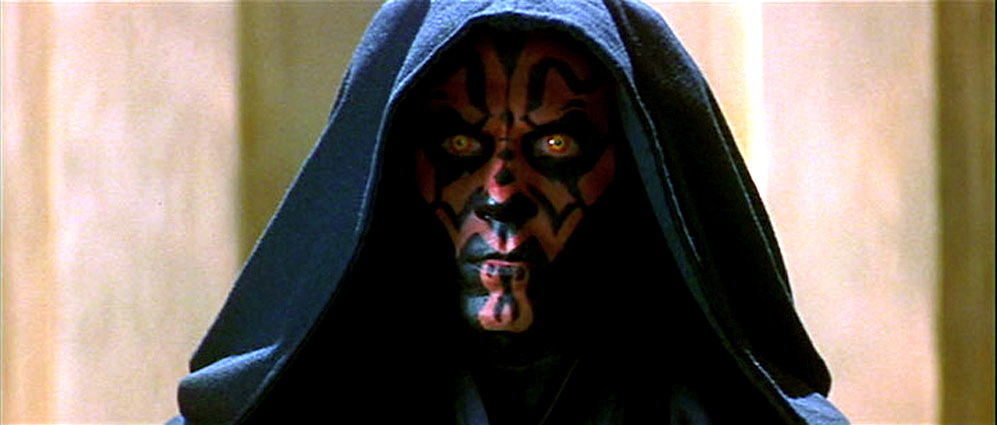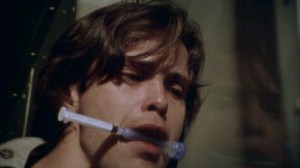(this article originally appeared at screenwriting
website Twelvepoint.com, July 2010)
I stepped out of Star Wars: Episode 1 – The Phantom Menace (1999) onto the sidewalk in front of Mann’s Chinese, the second screening of opening day. As I stood there, arranging the debriefing session with my fellowgeeks, an awful thought kept surfacing – like a Dia Nogu’s algae-draped eyeball.
I thought…I thought, well…maybe I hadn’t enjoyed George Lucas’ long-awaited return as much as I should have.
I had “a bad feeling”.
But you can’t just say you have “a bad feeling” if you’re serious about studying and making movies. If something is astink, you are obligated to find out exactly why. We had looked forward to the return of the Star Wars saga for years, anticipating how wonderful it was going to be. It was not wonderful. Why?
The Phantom Menace is by no means entirely lousy. In fact, despite how universally the film is disparaged, it is not the worst Star Wars movie. The worst Star Wars movie is Episode 2 – Attack of the Clones (2002). Some of the film’s design is superb. Darth Maul – an exquisite cross between a predatory animal and a demonic monk – is one of the best character designs in all of Star Wars, and the final duel between Qui-Gon, Obi-Wan and Darth Maul is one of the best action scenes of the entire saga.

So what is the key failing of The Phantom Menace? It’s not the awful dialogue, which isn’t, on the whole, much worse than in any of the other Star Wars movies, discounting the babblings of the reprehensible Jar Jar Binks. It’s not Jar Jar himself either that destroys the movie. We would like to lay all the blame on Jar Jar: ‘Oh, if it weren’t for Jar Jar, TPM would be pretty good.’ No. No, it wouldn’t. And it’s not the performances either – though, it’s true, most of them are shockingly strangled and lifeless.
The central flaw is, as usual, a script problem, and it’s such a fundamental script problem that no amount of clever, high-tech decoration can disguise it.
In trying to sleuth out exactly why a story doesn’t work, it’s good to put it up next to a story that you know does work. The original Lucas masterpiece, Star Wars: Episode IV – A New Hope (1977) – which I always call simply “Star Wars”, and so should you – is held up as a paragon of solid script structure, and for good reason. Its simplicity and clarity makes it easy to analyse and understand and, furthermore, it’s a movie everyone has seen, which makes it easy to talk about. It’s also one of the most successful entertainments in history so there ought to be some value in studying it carefully.
When we put the script for The Phantom Menace side by side with the script from Star Wars, one feature distinguishes them from each other more than any other, an element triumphantly strong in one film, almost laughably weak in the other. The stakes. The singular difference between the beloved 1977 original film and The Phantom Menace and the reason for latter’s failure is the height of the stakes.
High stakes are essential to telling a good story. “High stakes” doesn’t have to mean the threat of a bomb exploding in five minutes. A teen’s parents coming home in five minutes is more than enough to put us on the edge of our seats. It isn’t threats of physical torment that determine high stakes either – simply missing a bus can be the most devastating moment in a character’s life.
What determines the height of the stakes is how far apart the poles are of success and failure, as well as the character’s depth of commitment to achieving success. There is little middle ground in the best stories. In the movies we love, a character may strive for great success but the penalties for failure are equally great. The best stories not only have a Devil, they have a Deep Blue Sea.
In the greatest sports movies, for example, the stakes are rarely about whether or not the character will win. The character’s desire to win is usually paired with a penalty for failure that is psychologically catastrophic. In Chariots of Fire (1981), Harold Abrahams and Eric Liddell certainly want to win but the tension of the story comes from their utter commitment to their calling, their commitment to their true selves. It goes beyond a desire to win a race. These men have left themselves no room to retreat; they are committed to an idea of themselves and of their futures. The genius of the Chariots of Fire script is that its climax hinges on the characters’ even greater commitment to personal honour and mutual respect, which is far greater than the desire for a medal.
It’s easy to think that death is the worst thing that could happen to a character. In the world of flesh and blood, this may or may not be true, but movies exist in the world of emotion. And an emotional catastrophe – one that is going to be communicated to the audience – can take a million forms and will almost always be more violent than any physical slaughter.
So back to our two Star Wars movies. Let’s take the five main characters from each film and examine the stakes each character faces -what action is asked of each character and what are the penalties of failure?
In Star Wars:
- LUKE must deliver R2D2 safely into the hands of the rebellion. If he fails, the fully-operational Death Star will mean the end of the rebellion – and of galactic freedom.
- DARTH VADER must retrieve the stolen Death Star plans and learn the location of the secret rebel base. If he fails, the rebels could destroy the Death Star and cripple the power of the Empire, and he will have a lot of explaining to do to the Emperor.
- HAN SOLO must pay back Jabba The Hutt. If he fails, he will be a fugitive, fleeing bounty hunters and ruthless gangsters for the rest of his life (wonderfully, he does fail in order that the other characters may succeed).
- PRINCESS LEIA must retrieve the plans for her fellow rebels. If she fails, it will mean the end of the rebellion.
- OBI-WAN KENOBI must get the plans safely to the rebels. If he fails, it will mean the end of the rebellion.
Looking at The Phantom Menace, we see a different picture:
- QUI-GON JINN must negotiate a peace between the Trade Federation and the Naboo. If he fails, the Trade Federation may take over the planet Naboo. Never really clear why this would be a terrible thing.
- QUEEN AMIDALA must stop the Trade Federation from dominating her planet, it would seem. If she fails she will no longer rule – and someone else will, I guess.
- DARTH SIDIOUS must make Queen Amidala sign a treaty with the Trade Federation. If he fails, the status quo will probably continue.
- ANAKIN SKYWALKER must increase his understanding of The Force and return to Tatooine to free his mother and the slaves. If he fails, he will have broken his promise to his mother. (note that he does fail, with no real consequences to anyone, including himself)
- JAR-JAR must do what he can to help Qui-Gon and Obi-Wan. If he fails, it’s doubtful the Jedis’ mission would be negatively affected and the status quo will continue.
The lack of consistent high stakes in The Phantom Menace is the movie’s main flaw. Almost across the board, the price of a character’s failing is simply that the status quo will continue or the slack will be picked up by some other character.
In Star Wars, the few main characters are the only people in the galaxy who can pull off the necessary task to resolve the conflict. In The Phantom Menace, few characters are really essential. If, say, Qui-Gon and Obi-Wan were cut from the story altogether, would anything in the world of the story have changed? I tend to doubt it. The Trade Federation probably still would have invaded and Amidala would still have been forced to lead some kind of armed resistance in the Act III.
If Anakin – who will become one of the most famous characters in cinema – had never appeared in the film, would there have been any alteration in the story? Not likely. Apart from the destruction of the Trade Federation command ship – a lucky accident – Anakin is superfluous to the story. And two Jedi Knights who are supposed to be expert negotiators could certainly have drummed up spare parts for their ship without resorting to gambling on the life of a child.
The Phantom Villain of the movie, Darth Sidious, who is manipulating the Trade Federation, makes many villainous pronouncements but for no clearly discernible purpose. We have no reason to think he would sleep any worse for not making them.
Compare that to Vader and Grand Moff Tarkin’s predicament in Star Wars, where the Emperor himself is counting on Tarkin and his armoured bulldog to solve the problem – and fast. And it is a big problem. The secret plans for the keystone of the Empire’s new military strategy are flitting around the galaxy somewhere, possibly in the hands of the very people they are trying to crush.

It’s been said over and over that if you want to make your hero’s story better, give him a better villain. Star Wars, in a very few strokes, conveys a great weight of responsibility on the villains. They can’t just decide to focus their energies elsewhere or wait for it all to blow over. If they fail, it’s their careers, their lives and the lives of all their associates, not to mention the staggering investment in money, manpower and ideological commitment that the Death Star represents.
Also note how in Star Wars all the characters – protagonists and antagonists – are bound together by the same problem. Whatever the outcome is, every character will be permanently affected. It is simply not possible for any of the principal characters – even the minor characters, for that matter – to pass through the story without being changed for the worse or the better. In fact, no one in the entire galaxy will be unaffected by how the story plays out. Those are high stakes. That’s how you tell a story.
